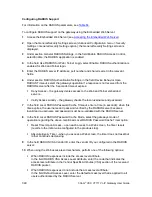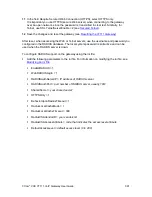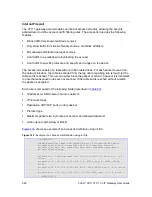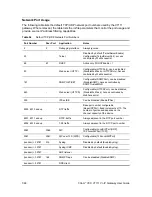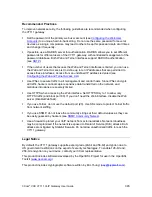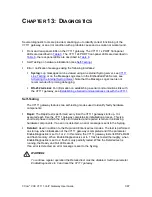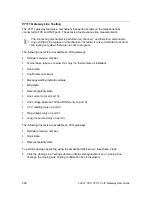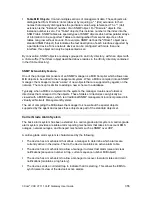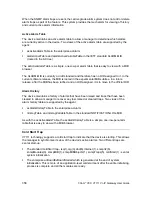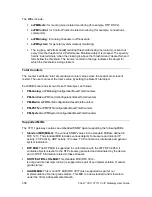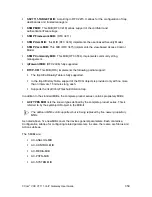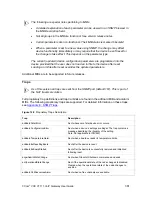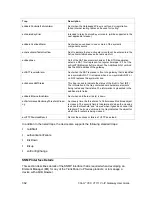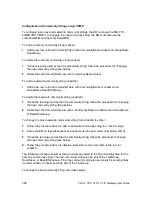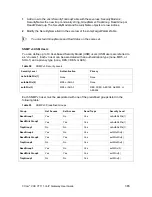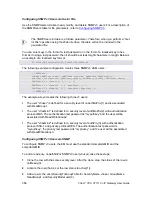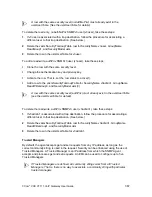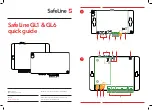
354
3Com
®
VCX V7111 VoIP Gateway User Guide
Trap:
A message generated asynchronously by network devices. It is an unsolicited
message from an agent to the manager.
Each of these message types fulfills a particular requirement of Network Managers:
Get Request:
Specific values can be fetched using the get request to determine the
performance and state of the device. Typically, many different values and parameters
can be determined using SNMP without the overhead associated with logging into the
device, or establishing a TCP connection with the device.
Get Next Request:
Enables the SNMP standard network managers to walk through all
SNMP values of a device (using the get-next request) to determine all names and values
that an operant device supports. This is accomplished by beginning with the first SNMP
object to be fetched, fetching the next name with a get-next, and repeating this operation.
Set Request:
The SNMP standard provides a method of effecting an action associated
with a device (using the set request) to accomplish activities such as disabling interfaces,
disconnecting users, clearing registers, etc. This provides a way of configuring and
controlling network devices using SNMP.
Trap Message:
The SNMP standard furnishes a mechanism by which devices can reach
out to a Network Manager on their own (using a trap message) to notify or alert the
manager of a problem with the device. This typically requires each device on the network
to be configured to issue SNMP traps to one or more network devices that are awaiting
these traps.
The above message types are all encoded into messages referred to as Protocol Data Units
(PDUs) that are interchanged between SNMP devices.
SNMP MIB Objects
The SNMP MIB is arranged in a tree-structured fashion, similar in many ways to a disk
directory structure of files. The top level SNMP branch begins with the ISO internet directory,
which contains four main branches:
"mgmt
"
SNMP branch:
Contains the standard SNMP objects usually supported (at least
in part) by all network devices.
"private
"
SNMP branch:
Contains those ‘extended’ SNMP objects defined by network
equipment vendors.
"experimental" and "directory" SNMP branches:
Also defined within the ‘internet’ root
directory, these branches are usually devoid of any meaningful data or objects.
The tree structure described above is an integral part of the SNMP standard, though the
most pertinent parts of the tree are the leaf objects of the tree that provide actual
management data regarding the device. Generally, SNMP leaf objects can be partitioned into
two similar but slightly different types that reflect the organization of the tree structure:
Discrete MIB Objects:
Contain one precise piece of management data. These objects
are often distinguished from "Table"items (below) by adding a ".0" (dot-zero) extension to
their names. The operator must merely know the name of the object and no other
information.
Summary of Contents for VCX V7111
Page 30: ...30 3Com VCX V7111 VoIP Gateway User Guide Readers Notes ...
Page 44: ...44 3Com VCX V7111 VoIP Gateway User Guide Readers Notes ...
Page 53: ...3Com VCX V7111 VoIP Gateway User Guide 53 Readers Notes ...
Page 54: ...54 3Com VCX V7111 VoIP Gateway User Guide ...
Page 211: ...3Com VCX V7111 VoIP Gateway User Guide 211 Figure 76 IP Connectivity Screen ...
Page 235: ...3Com VCX V7111 VoIP Gateway User Guide 235 Readers Notes ...
Page 236: ...236 3Com VCX V7111 VoIP Gateway User Guide ...
Page 240: ...240 3Com VCX V7111 VoIP Gateway User Guide Readers Notes ...
Page 245: ...3Com VCX V7111 VoIP Gateway User Guide 245 Readers Notes ...
Page 246: ...246 3Com VCX V7111 VoIP Gateway User Guide ...
Page 281: ...3Com VCX V7111 VoIP Gateway User Guide 281 Readers Notes ...
Page 282: ...282 3Com VCX V7111 VoIP Gateway User Guide ...
Page 298: ...298 3Com VCX V7111 VoIP Gateway User Guide Readers Notes ...
Page 315: ...3Com VCX V7111 VoIP Gateway User Guide 315 Readers Notes ...
Page 316: ...316 3Com VCX V7111 VoIP Gateway User Guide ...
Page 319: ...3Com VCX V7111 VoIP Gateway User Guide 319 Readers Notes ...
Page 320: ...320 3Com VCX V7111 VoIP Gateway User Guide ...
Page 346: ...346 3Com VCX V7111 VoIP Gateway User Guide Readers Notes ...
Page 351: ...3Com VCX V7111 VoIP Gateway User Guide 351 Readers Notes ...
Page 352: ...352 3Com VCX V7111 VoIP Gateway User Guide ...
Page 376: ...376 3Com VCX V7111 VoIP Gateway User Guide Readers Notes ...
Page 386: ...386 3Com VCX V7111 VoIP Gateway User Guide Readers Notes ...
Page 394: ...394 3Com VCX V7111 VoIP Gateway User Guide Readers Notes ...
Page 396: ...396 3Com VCX V7111 VoIP Gateway User Guide Readers Notes ...
Page 405: ...3Com VCX V7111 VoIP Gateway User Guide 405 Reader s Notes ...
Page 406: ...406 3Com VCX V7111 VoIP Gateway User Guide ...
Page 410: ...410 3Com VCX V7111 VoIP Gateway User Guide ...
Page 426: ...426 3Com VCX V7111 VoIP Gateway User Guide Readers Notes ...
Page 432: ...432 3Com VCX V7111 VoIP Gateway User Guide Figure 153 Prerecorded Tones Screen ...
Page 452: ...452 3Com VCX V7111 VoIP Gateway User Guide Readers Notes ...
Page 456: ...456 3Com VCX V7111 VoIP Gateway User Guide Readers Notes ...

